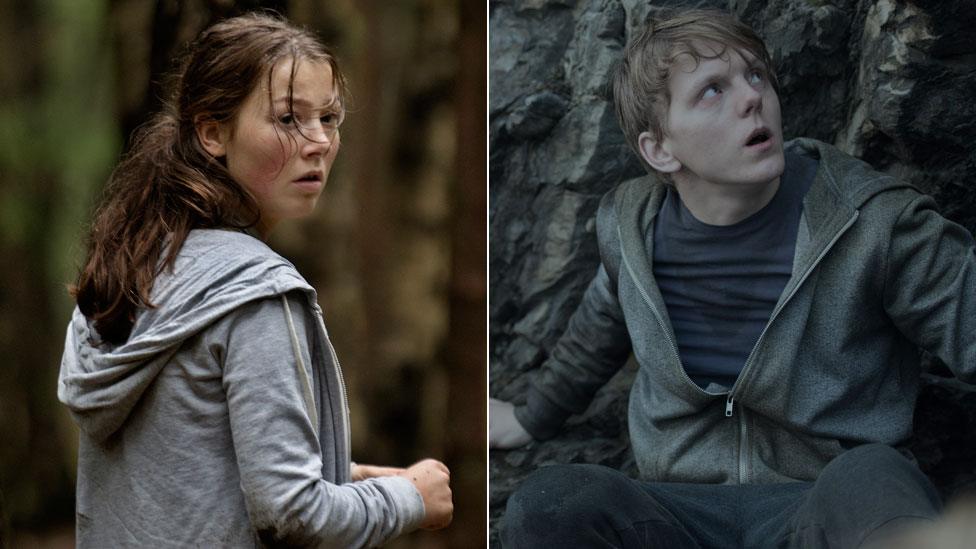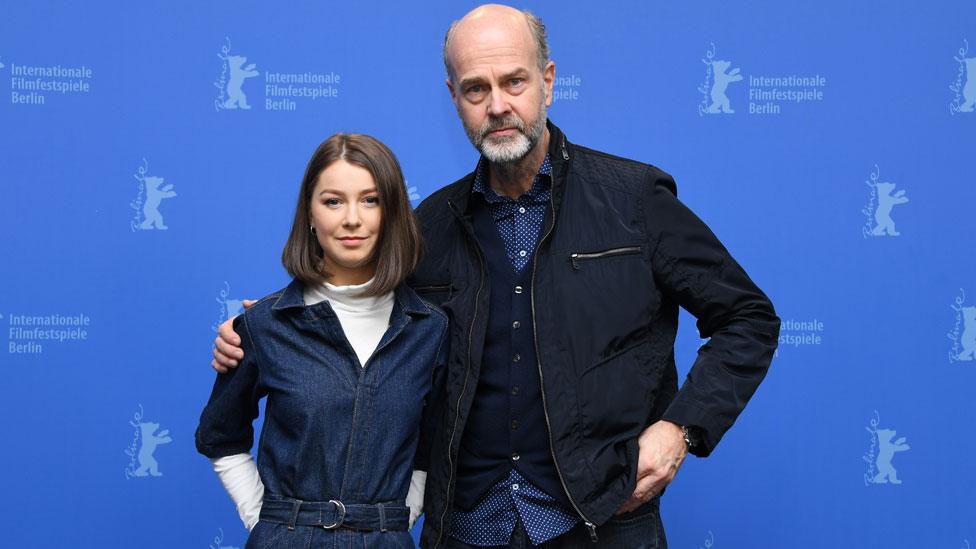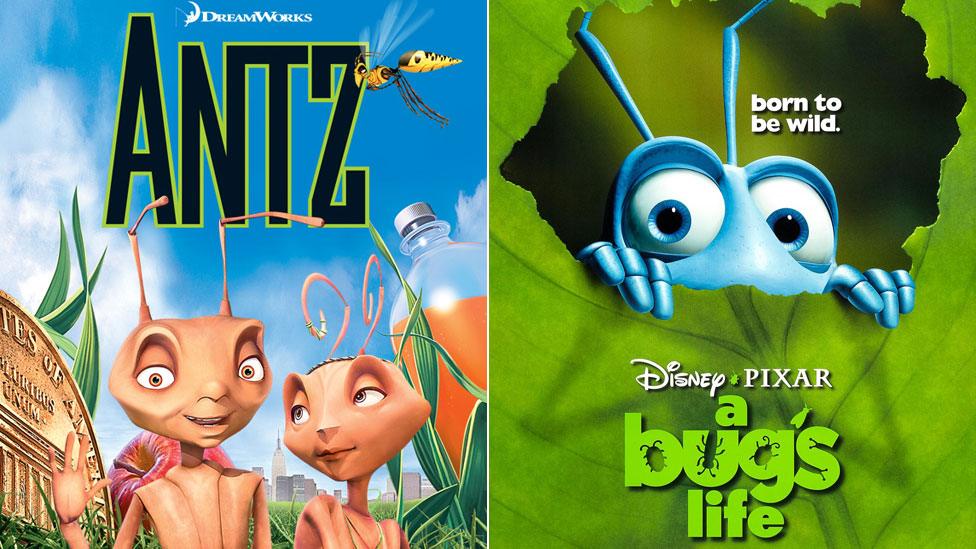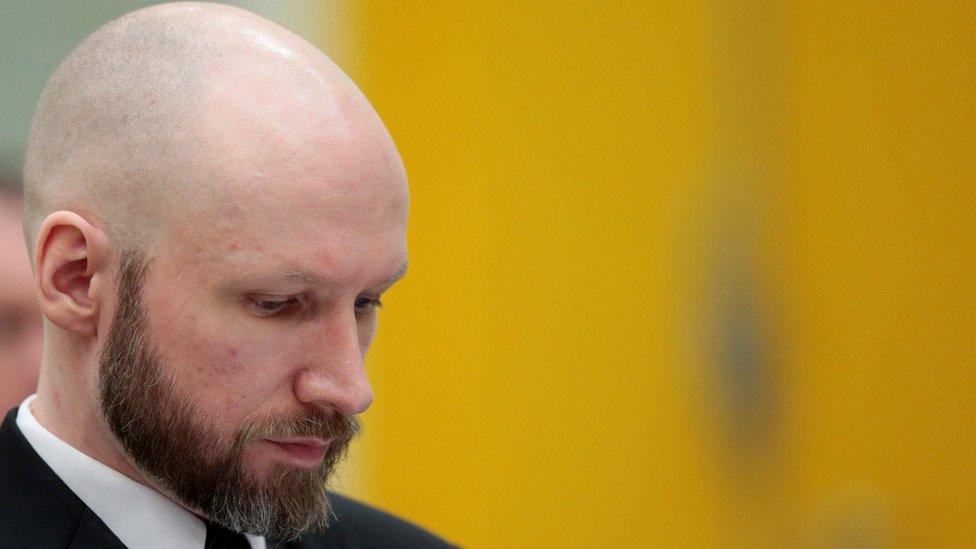Utoya on screen: How two film directors tackled the same tragedy
- Published

Andrea Berntzen in Utoya - July 22 and Jonas Strand Gravli in 22 July
Seven years on from Norway's deadliest terror attack, two new films offer radically different approaches to depicting what happened - and why.
On the afternoon of 22 July 2011, far-right extremist Anders Behring Breivik detonated a car bomb in central Oslo, killing eight people and injuring 209.
Later that day Breivik - dressed in police uniform - took a ferry to Utoya, an island on a lake about 20 miles (35 km) north-west of Oslo.
There he carried out a mass shooting at a youth camp run by Norway's Labour Party. By the time police arrived on the island, over an hour later, 69 people were dead and another 33 wounded.
The twin terror attacks sent shock waves across Europe and the world, with many seeing them as emblematic of a global resurgence in virulent nationalism.
Now, seven years on from the attacks, the events of 22 July have inspired two films that attempt to convey the chaos, horror and tragedy experienced by so many.

Anders Breivik gives a Nazi salute during a court appearance last year
Both films are accomplished works made with sensitivity and respect. Inevitably, though, they raise questions as to whether events of this nature can and should be recreated on screen.
Paul Greengrass, the British director of Bloody Sunday, United 93 and Captain Phillips, has experience of turning harrowing real-life events into intense and hard-hitting feature films.
His latest work, called 22 July, begins on that day. The rest of the film deals with Breivik's trial, his lawyer Geir Lippestad and Viljar Hanssen, a student who, despite being shot five times, recovered sufficiently to give evidence.
"The film's not really about the attacks," says Greengrass. "It's a story about how Norway fought for her democracy.
"Hundreds of survivors went into court and confronted Breivik with idealism, personal feelings and dignity. By doing that, they defeated him."
Film director Paul Greengrass says survivors of the attack "vanquished" Breivik's ideology
According to the director, "it was vital to go to Norway and work with a Norwegian cast and crew." (The film is in English, he says, because he "doesn't speak Norwegian".)
"I said to the actors, 'This is your country and you know things I can't possibly know," he goes on.
"I don't think it's a nihilistic film," he continues. "Without sentimentality and offering cheap solutions, you have to believe there are answers to the challenges of our times.
"The idea that democracy is not a given and has to be argued and fought for is something we'll have to get used to."
Greengrass rejects the notion that putting Breivik on screen may inadvertently give him another platform for his unpalatable world views.
"I don't think you can make sense of what he did without exploring who he was and peeling the onion," he goes on.
Yet another film made about the attacks makes a different choice entirely - to not feature Breivik as a character, but treat him instead as an unseen or far-off threat.
Erik Poppe, the Norwegian director of Utoya - July 22, tells the BBC he felt it was "morally questionable" to devote time to "portraiting" such an individual.
"The last thing I wanted was to give him more social media fame," he goes on. "I wanted it to be a story about the victims."

Anders Danielsen Lie (left) plays Anders Breivik in Paul Greengrass's film
Poppe's film consists of one long, seemingly unbroken take that follows one young girl on Utoya experiencing the attack in 90 minutes of real time.
Its heroine is Kaja, a fictional character desperately trying to find her younger sister as the island is gripped by fear and confusion.
We hear shots but, like Kaja and her fellow students, cannot fathom their origin - apart from in one scene in which a figure is seen aiming a rifle from a long distance away.
Poppe says he chose to make Kaja a fictional composite in order to "make a reflection of what happened out there, as close as possible to what I learned".
"There were ethical reasons for me to tell a fictionalised story," he continues. "It would be hard for the survivors to watch the film if they thought these people were friends who had been killed."
Poppe says he was already well into production when he became aware of Greengrass's film. Yet he hopes their films can together "present a wider picture of what happened".
Greengrass too believes the two films - along with the books, documentaries and TV series the attacks have inspired - are part of "a healthy process of exploration".

Poppe with actress Andrea Berntzen at the Berlin Film Festival, where Utoya - July 22 premiered
"You can only make the film that you can make and you're only putting one brick in a wall, and many other people will be putting theirs in as well," he goes on.
"When you get moments like 9/11 and 22 July that are huge challenges to democratic norms, culture has to process them. It's the way we make sense of our world."
Breivik admitted carrying out the attacks but denied criminal responsibility. He was found guilty of terrorism and premeditated murder and sentenced to 21 years in prison.
An independent report into the attacks concluded the bombing could have been prevented and criticised police for not responding to the shootings quicker.
Breivik has been kept in solitary confinement since shortly after his arrest. Last year he changed his name to Fjotolf Hansen and he recently applied to take a political science degree.
It is possible, if unlikely, he will one day see the films that have been made about his actions. Is that something their directors would endorse?
Greengrass's response is terse. "I have no feelings about Breivik at all," he states. "He's rightly imprisoned and I've no interest in him - zero."
Poppe also says he "does not care" about Breivik but is prepared at least to entertain the notion.
"Some say maybe he should see our film as a wake-up call," he tells the BBC. "Others say he will never wake up and he will never understand what he did.
"The day he regrets and starts to question his own act, that might be the moment for him to watch the film."
22 July is released in select cinemas and on Netflix on 10 October. Utoya - July 22 screens at the London Film Festival and opens in the UK on 26 October.

Follow us on Facebook, external, on Twitter @BBCNewsEnts, external, or on Instagram at bbcnewsents, external. If you have a story suggestion email entertainment.news@bbc.co.uk.
- Published2 October 2018

- Published2 April 2018

- Published1 March 2017
